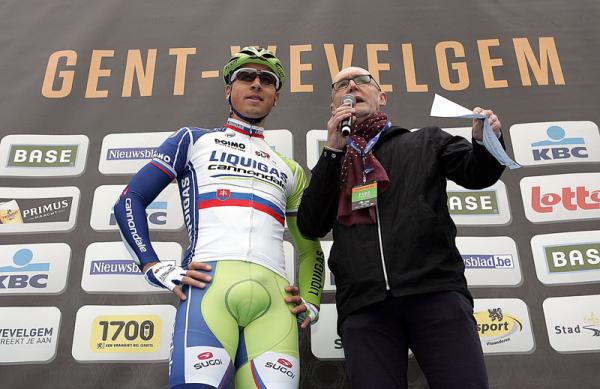Sagan primed to take on Boonen at the Tour of Flanders
Tougher course may not mean tougher race, says Slovak



It’s sometimes easy to forget Peter Sagan’s tender years, but the Liquigas-Cannondale rider’s first memories of watching the cobbled classics on television are a stark reminder of how far he has travelled since turning professional two years ago.
“Tom Boonen was the first one that I knew as the strongest for the classics, so he stuck in my mind,” Sagan told Cyclingnews in Kortrijk, as though Tommeke’s first triumphs on the cobbles belonged to some distant, sepia-tinged era.
“I watched the classics when I started off cycling, they were always on Eurosport. To be honest I would have watched Paris-Roubaix more than the Tour of Flanders, but I can see now how important Flanders is too.”
On Sunday, Sagan will do battle against Tom Boonen on his home patch at the Tour of Flanders, but any inhibitions the 22-year-old may have had when he turned professional in 2010 have been loosened by the steady flow of success he has enjoyed since. “It affected me at the start to be alongside a rider like that, but now when I ride with him I don’t see him like that anymore, I’m more used to it,” he said.
Sitting in the bar of the Kennedy Hotel in Kortrijk, which Liquigas shares with Omega Pharma-QuickStep as its classics base, Sagan nursed an espresso as he mulled over his performances in the build-up to De Ronde. At both E3 Harelbeke and Gent-Wevelgem, he went on the offensive rather than bide his time for the sprint. Given that he then managed a close second behind Boonen in Wevelgem, he could have been forgiven for regretting his impetuousness.
“I certainly made some errors on Friday and on Sunday but a second place isn’t too bad and in the end I think Boonen was stronger in the sprint, what can I say,” said Sagan, who admitted that his rally off the front with Fabian Cancellara had cost him some energy for the finale.
“But my directeurs sportifs agreed that if I hadn’t gone in the break with Cancellara, maybe they wouldn’t have started riding hard in the group behind and Cavendish could have got back on.”
The latest race content, interviews, features, reviews and expert buying guides, direct to your inbox!
While Cancellara has famously struggled to find willing accomplices in breakaways in the classics in recent times, Sagan had no qualms about taking turns on the front with the Swiss rider after they forged clear on the Monteberg at Gent-Wevelgem, explaining that it didn’t sit with his racing philosophy.
“If I go in a break, I want to try and win, but it’s not nice if someone else pulls me along for 30km and then I beat him in the sprint. I don’t think that’s right. Even if he’s stronger and taking a few turns means that I finish it second, it’s always better that way than doing something else.”
Looking to De Ronde
On Tuesday’s opening stage of the Three Days of De Panne, Sagan was again on the offensive, but this time he kept enough under the saddle to win the sprint in Oudenaarde. Mindful of the main event on Sunday, however, he opted to sit up in the finale of stage two and surrender his leader’s jersey, shedding with it the obligation to ride the final day of the race.
“We raced because we want to do some preparation for Flanders,” he said. The implication is clear – the Slovak expects to be in the thick of the action on Sunday, when the race tackles the testing circuits over the Kwaremont and Paterberg.
Sagan’s experience on the old finale over the Muur and Bosberg was limited to one crash-blighted appearance last year, but he wondered if the tougher course would lead to a less aggressive race. “I’ve heard it will be harder and we’ll do three laps where there are those climbs. We’ll see. If it’s harder it means that it will be slower, I think. Or at least I hope,” he joked.
“In my first years at Liquigas as a professional, before the big races I was always a bit stressed, I was thinking about how the race might go. It wasn’t very good, but now I get there more relaxed and I try not to think too much about what’s going to happen in the race.”
Not surprisingly, Sagan anticipates that those same figures he watched battling it out on television a few short years ago will be the men to beat this time around, namely Boonen and Cancellara. “It’s always the same riders every year who show they are strong, and that they have the class to do well in these races,” he said.
Yet while the Boonen-Cancellara duel seems set to dominate the build-up to the race, a potential tactical stalemate between their teams could yet play into the hands of a cabal of other contenders, Sagan included. “You could have a situation like Nuyens at Flanders last year,” he said. “It could be that where two come up against one another, a third might slip away and win.”

Barry Ryan was Head of Features at Cyclingnews. He has covered professional cycling since 2010, reporting from the Tour de France, Giro d’Italia and events from Argentina to Japan. His writing has appeared in The Independent, Procycling and Cycling Plus. He is the author of The Ascent: Sean Kelly, Stephen Roche and the Rise of Irish Cycling’s Golden Generation, published by Gill Books.